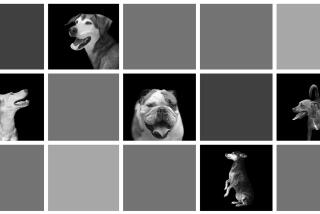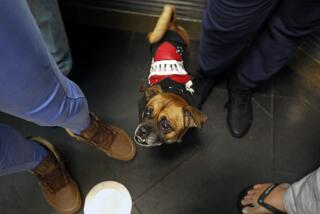Effective lost-pet posters
- Share via
Less than 2% of lost cats and less than 20% of lost dogs are returned to their owners, according to the National Council on Pet Population Study and Policy, a nonprofit organization whose members include the Humane Society of the United States, the American Society for the Prevention of Cruelty to Animals and the American Veterinary Medical Assn.
Microchips are crucial, but an old-fashioned lost-pet poster can be important too. Making an effective flier is an art unto itself. Six common mistakes to avoid:
Photo selection: If your missing pet has distinctive markings or a memorable shape, a full-body photo is wise. Otherwise, you might simply show the animal’s face. When viewed from a passing car, full-body photos can be hard to make out. But a large face photo can grab attention: It’s more graphic, easier to see from afar and emotionally compelling.
Text selection: Sans-serif fonts such as Arial allow for bolder letters that are easier to read from afar. Many people put “LOST DOG” in the biggest type, but everyone can infer that these fliers are for a lost pet. A more effective strategy is to put key visual descriptions in the biggest font: “BLACK LAB” or “TERRIER PUPPY.” These key words might resonate immediately with passersby and stick in their heads.
Sign locations: Fliers on streetlights and utility poles might be pulled off within days by city workers just doing their job. Consider making some larger staked signs — poster board, not paper — and asking homeowners on key streets to put them in the yard, perhaps near a sidewalk or intersection. Use fluorescent poster board, either as the sign itself or an eye-grabbing backdrop. An 8½-by-11-inch flier stands out better if glued to a larger piece of colorful poster board.
Number of copies: Print enough fliers to hand out to neighbors and dog walkers. Sympathetic pet owners can essentially expand your search team.
Preparedness: When an animal goes missing, time feels crucial. With every passing minute, that dog may be wandering farther from home. So treat a missing pet like an earthquake: Prepare the emergency kit in advance. Create your flier now, include the best photo and update it every year. Put the design in multiple places, including a flash drive stored with tape and a staple gun. Then you won’t get stuck sorting photos and shopping for supplies when you’d rather be on the streets searching.
6. Hope: Don’t lose it. SPCALA has an “Animal Finder” advice sheet that says a lost pet can wander for months, and people who find lost pets may keep them for weeks before taking them to a shelter. We’ve posted this advice sheet to our L.A. at Home blog, latimes.com/home.
— Craig Nakano


